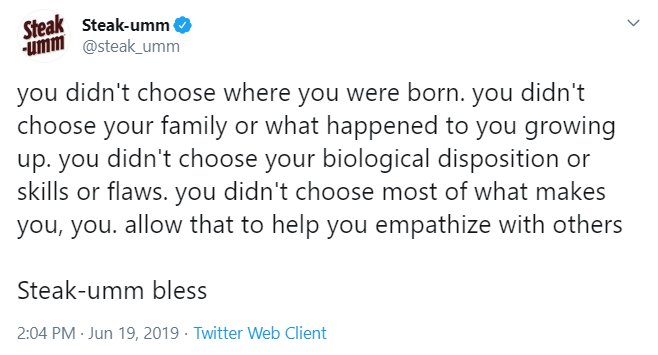The Future of Your Brand Is Invisible

The Industrial Age narrative has been the prevailing story of our time. Lying at the core of that story are the values of extraction and tangible assets. But new stories are emerging that shun the extraction economy. The knowledge economy, the attention economy, and the cultural economy are now popular terms, describing the value of intangibility (i.e., invisible things). The most powerful assets are those that are invisible in a traditional sense, yet operate with outsize influence.
As the power of invisibility becomes dominant, how will brands effectively navigate an unknown and unseen reality? Research and development, emotional intelligence, and data are verticals where harnessing the power of invisibility can unlock brand value. Consider:
R&D > Marketing
Branding has always straddled the fence as a known measurable quality and being more ethereal (i.e., invisible). We know that brand matters, but to what extent and how do you effectively measure its impact? If one assumes that an organization's brand is derived from its values, then how it actively manifests those values and communicates them is essential.
So, "brand" lives simultaneously in two spaces: the lived work and communication of the brand, and how others interpret that work and communication. How an organization is perceived and how it aligns with people's values are part of any brand story. In that sense, branding always has qualities of invisibility. Those invisible qualities can be a source of uneasiness; as conventional thinking says, "What you can't see, you can't measure."
Branding is most often sequestered in the domain of marketing. Crafting a brand message that is coherent and has consistency is, therefore, in the hands of marketers and agencies. The quality of brand messaging varies wildly based on budget and corporate will. In fact, over the past decade, marketing, as measured by the percentage of advertising spend of the total budget, is on the decline.
Spending on R&D, by comparison — defined as expenditures in technology, innovation, and engineering — is rising. R&D, with its speculative nature, explores what is possible but unseen. Organizations investing in R&D are seeking the unknown and committing resources toward discovery. The significant expenditures committed to R&D could lead to new products and brand extensions.
Brand identity will likely become more connected to the values of invisibility. The unknown is, by nature, invisible because it has not yet taken form. Budget commitment will ensure that R&D's role in brand building will continue to grow.
Emotional Attachment Is Front and Center
We live in a period of abundant choices and a scarcity of time. We pay for access to products and services with more than money, as our attention is also currency. Getting our attention (and our money) is among the primary challenges that brands face. The emotional attachment needed to build a reliable connection between a brand and a human being is highly coveted but rarely actualized. Attention is often only granted once there is an emotional attachment at work to make the time investment a worthwhile exchange.
Millennials and Gen Z frequently cite that brands sharing their values is an essential way they build a connection. At the same time, trust in traditional institutions (e.g., business, government, media, and religion) is declining. Reconciling these two realities can only happen when a meaningful emotional attachment is nurtured. Emotional connection is elusive but valuable to brands. Steak-umm, a U.S.-based frozen sandwich brand, uses its Twitter feed to post irreverent, but value-based messaging designed to resonate emotionally.



Steak-umm is speaking authentically to the values of its audience. It is an unlikely example of how emotional attachment can make significant inroads toward forging a real brand connection.
The World of Data Is Flat
Big data is the latest supposed panacea, heralded by organizations as the tool that will unlock invaluable insights into their business. There is no doubt that gathering vast troves of data can be useful, but that reality is not all-encompassing. The reliance on data often supports already existing biases toward tangibility and measurable outcomes. What is most important, however, can't always be measured.
As I have argued before, if you believe "data is the new oil," you need to rethink that position. Brands promote storytelling but resist the emotional resonance that exists within the models of the world that humans have created that defy neat classification. Brands that rely on data to drive their stories miss the connective tissue between those data points.
Moreover, it's in that connected, yet often unseen, tissue that real value is unlocked. Brand work is human work and buried within all that data there is a social context that is irreducible in its complexity.
Data is also not immune to the sticky human challenges of bias, inequality, and access. Turns out the data we don't collect and measure — invisible gaps in our knowledge — are just as critical as what we do measure. Relying solely on what is visible is no different from the belief that the world is flat. The information that is shaping our reality is increasingly manipulated and fake. If we can't "trust our eyes," then perhaps we need to trust our hearts and guts. The invisible dots within data can provide a buffer against bias or outright deception.
What We Don't See
The ability to measure and quantify phenomena suggests having a certain level of control over the future. The reality is that the future is mostly uncertain and unknown to us. We shouldn't reject this notion, but rather should embrace it, because that uncertainty is an opportunity. Organizations that achieve a higher level of comfort with invisibility will offer themselves the best chance to connect deeply with human beings. Successful branding requires leaps into the unknown and the unseen now more than ever.
Don't stop now! Stay in the know on the impact of D&I, influence and influencers, and marketing in culture with more from Phil McKenzie.
Click the social buttons to share this story with colleagues and friends.
The opinions expressed here are the author's views and do not necessarily represent the views of MediaVillage.com/MyersBizNet.


